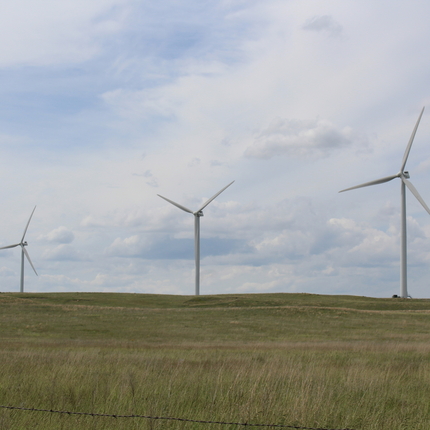By Lucas Nelsen, former staff member
Residents of the Great Plains are no strangers to windy conditions, or to the potential to use this resource to generate clean energy. While solar has boomed, wind energy continues to be the leading renewable energy industry in the region. States with great wind energy potential, like North Dakota, have a chance to develop these resources and reap the benefits of being a renewable energy leader.
North Dakota ranks sixth in the nation for wind energy potential, offering more than 770,000 MW of renewable energy from the state’s wind resources alone. To put that into perspective, that output could meet the state’s energy needs 230 times over. In 2017, wind energy accounted for 27 percent of the electricity that was generated in the state, producing 2,996 megawatts of installed capacity from 1,611 turbines installed.
Those numbers translate to increased revenue for communities and new jobs for North Dakota. According to a report by North Dakota State University in 2017, the wind industry supported 136 full-time equivalent jobs in operations and an additional 364 jobs were supported by business activity. North Dakota also hosts several facilities that manufacture wind energy components, with one manufacturer alone employing 1,013 workers. Combined with those created during the construction of projects, the wind industry supported about 3,000 direct and indirect jobs.
Development in North Dakota also provides a return to towns and counties in the form of new tax revenue, with wind farms generating revenue that feeds back into the local tax base. This revenue is gathered from a combination of property taxes on wind energy systems and an electric generation tax based on the capacity of the project as well as how much electricity it produces in a year. In 2016, wind energy provided $7.7 million in property tax revenue in the state—that revenue helps boost valuable local services like schools, fire and rescue, and police.
Landowners that host turbines also receive land lease payments that can range from $8,000 to $10,000 per turbine each year. Because these are paid annually, they can act as a guaranteed income for farmers and ranchers. This new income can help provide welcome stability to families that rely on the volatile agriculture market, as well as infuse money into local economies. It’s estimated that $14.4 million was paid to North Dakota landowners in 2016.
Wind energy presents a great opportunity for North Dakotans. The state is positioned to continue its role as a leader in the energy industry, but now with an eye toward producing clean and renewable solutions. However, there are still obstacles to fully capturing the benefits of wind energy in states like North Dakota. One challenge is updating the regional electric grid to connect new generating sources like wind energy. Another is for developers and regulators to work with community members to determine the best way to build new wind energy projects, while also addressing the questions and concerns of local stakeholders.
North Dakota has huge potential to generate renewable energy for itself and its neighbors. The state is perfectly positioned to be a renewable energy leader and realize the benefits of this growing industry. As advancement continues, local engagement will continue to be an essential requirement for successful clean energy projects.





